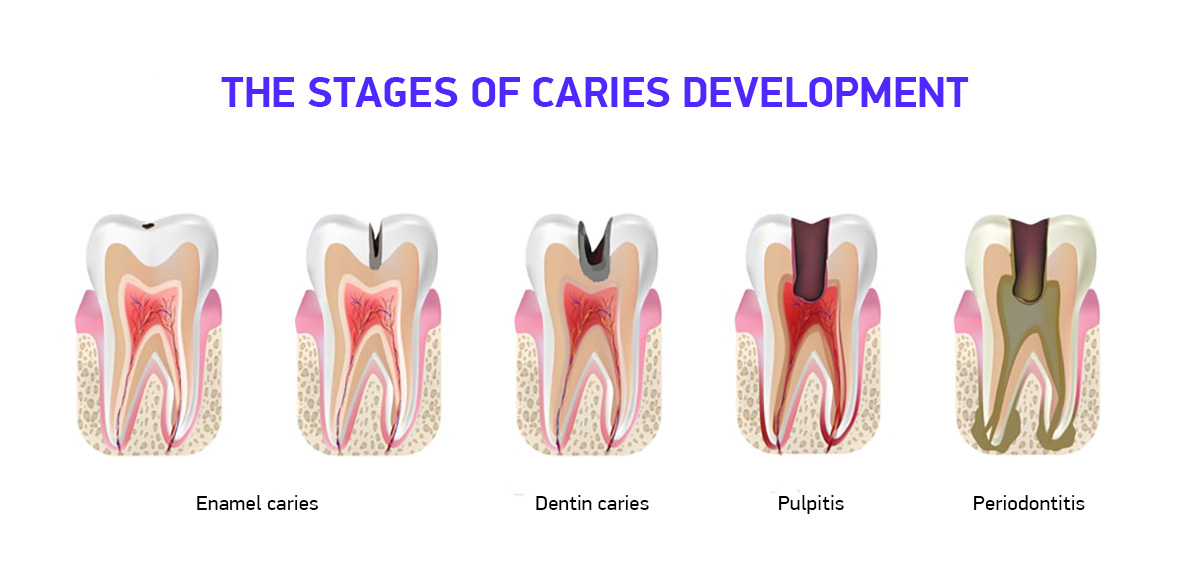Dental caries: types, symptoms and treatment
Almost every person in his life has encountered such a problem as tooth decay. But few people know the causes of its occurrence, as well as preventive measures. Therefore, let's figure out how tooth decay occurs on your teeth, how to identify and cure it.
The structure of our tooth consists of three levels:
- Enamel (performs a protective function)
- Dentin (nourishes a tooth)
- Cement (tooth roots performing the function of supporting the tooth in the bone)
Dental caries is a problem that most often affects 2 levels: enamel and dentin. But if you postpone the treatment process, then it can reach the dental nerve, which will subsequently lead to its removal.

Why is it important to preserve a tooth?
It is not advisable to remove the tooth nerve, since it is responsible for the health and strength of your teeth. So that you can safely eat your favorite food without worrying that the tooth will break. The tooth nerve is like the roots of a tree that give the plant strength and energy. Breaking a strong healthy tree is almost impossible. But if the roots cease to nourish it, it will become dry and brittle, and breaking it will be quite easy. The same thing happens with a tooth. If the nerve is removed, the tooth will no longer receive nutrients, trace elements and hydration, as a result of which it will become brittle and fragile.
What are the tooth surfaces and where does tooth decay most often occur?
In their shape, the teeth resemble a cube and have 6 surfaces: chewing, back and front, as well as 2 side surfaces near the cheek and palate. The 6th surface is the root of the tooth that goes into the gum. Tooth decay can form on any of the surfaces except the one that holds the tooth. Most often, dental caries occur on the chewing side of the teeth, as well as on the back and front surfaces of the tooth. Because the interdental spaces are a rather inaccessible place and it is not so easy to clean them ideally. For these purposes, it is necessary to use dental floss, special brushes or an irrigator.
Risk factors for caries
The most common cause of tooth decay in adults and children is insufficiently thorough oral hygiene. When we eat food, quite often in the interdental spaces, as well as on the chewing part of the tooth, small pieces of products remain that are difficult to remove. It is in these residues that after a few hours the so-called process of decay and the formation of microbes begins, which starts to destroy the tooth enamel. This all happens gradually, and when microbes destroy a small area of tooth enamel, they will begin to penetrate the inside of the tooth, affecting the dentin.
The decay of deciduous teeth is also dangerous, since they have fewer trace elements and dentin. Moreover, the nerve in the deciduous teeth is closer than in the permanent teeth of an adult, and by destroying the enamel, decay can quickly reach the dental nerve. Then, if you do not take measures to treat tooth decay, it can go further deep into the tooth, causing inflammation of the nerve, which later goes into the inflammatory process on the bone. And as a result, you will get flux and tooth extraction.

How to recognize tooth decay?
Sometimes tooth decay can be confused with age spots on the teeth. They can occur due to malnutrition, high fluoride water, smoking, and other bad habits. To make sure that you have tooth decay, not pigmentation, you need to make an appointment with a dentist for a consultation. The doctor will examine your teeth in more detail and talk about problems if any.
It is quite difficult for an ordinary person to notice dental caries in the early stages. The first sign that will help to recognize the development of this disease may be the appearance of the tooth. In a healthy person, the teeth are glossy, but if they start to be affected by tooth decay, they become dull. This means that microbes have begun to actively destroy tooth enamel and it's time to consult a dentist.
When microbes penetrate the dentin (the inside of the tooth), then small brown spots begin to appear on the teeth. If you have deep tooth decay, the spots may even be black. During tooth decay, your teeth become more sensitive to hot, cold, and also sweet. But we want to note that not all people have increased sensitivity. Therefore, having seen the first signs of tooth decay formation, it is urgent to make an appointment with the dentist until caries has gone too far, reaching the dental nerve.
Tooth decay treatment and diagnosis:
To recognize caries, the dentist needs to take an x-ray to confirm the diagnosis and find out how deep tooth decay is. If it does not reach the nerve, then treatment begins, if it comes too close to the tooth nerve, then the nerve will most likely need to be removed.

How to treat tooth decay?
After making a diagnosis, the doctor, using a special tool and preliminary anesthesia, begins to remove those layers of the tooth that have been affected by tooth decay. After that, the dentist in Riga cleans and disinfects the tooth and inserts a calcium pad (if tooth decay is deep). As soon as the tooth is dried, the stage of filling and shaping of a new healthy tooth occurs. On average, it takes about an hour to treat one tooth.
You can find out the prices for dental fillings on each surface in the “Prices” section.
Protect the health of your teeth and visit dentistry in Riga to recognize and prevent diseases on time!
Fill in the form for a free 15-minute video consultation (Zoom), or post your question on Facebook or in the email.








